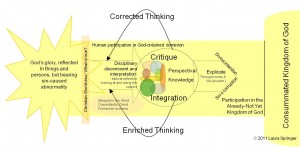In 2010, I completed the StrengthsFinder assessment tool. The results were enlightening, though not surprising (for me or those who know me–a testament to its usefulness):
The thing about strengths is that what is designed as an asset becomes a liability when the focus is awry. Input and learning become intellectual hoarding, intellection and ideation become ivory-tower-academia, and strategic becomes controlling. This week, as I reviewed the interdisciplinary integration model, I recognized the telltale signs of strengths-gone-awry. There was a gaping hole in my model: the output of the process was decidedly conceptual.
But life is not conceptual and our explication of it must go beyond words. The explication flowing from critique and integration transform life itself, for knowledge must not remain at the conceptual level. Knowledge must be lived. Lived knowledge is wisdom and wisdom, as Jeffrey mentions in his introduction to The Bible and the University, is the true end of education. Wisdom that aligns with God’s view of reality will be “pure, then peaceable, gentle, open to reason, full of mercy and good fruits, impartial and sincere” (James 3:17 ESV); it will naturally tend toward the sort of life that fits Christ’s consummated kingdom. Somehow, chemistry, sociology, psychology, calculus, theology, and physics work together to discern and interpret reality in order to develop wisdom in accordance with reality.
What that looks like in life, frankly, is something worked out in life together.
The updated model is below. Click the image for a larger version.
Your ponderings on the process are welcome.
Informing Readings:
- Jeffrey, “Introduction,” in Jeffrey, D. L. and C. S. Evans. Editors. The Bible in the University
, Zondervan (2007), pp. 1-16.
- Jeffrey, “‘Biblical literacy, academic freedom, and Christian liberty,” in Jeffrey, D. L. and C. S. Evans. Editors. The Bible and the University, Zondervan (2007), pp. 284-302.


